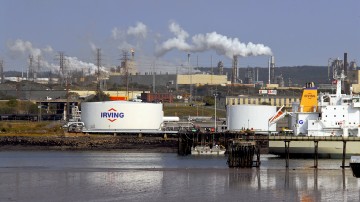

Plans shelved for new Saint John refinery
Shawn McCarthy
Globe and Mail
Saturday, Jul. 25, 2009
 Irving, BP decision based on forecast that gasoline consumption in North America has peaked |
Irving Oil Ltd. and partner BP PLC (BP-N50.65-0.05-0.10%) have shelved plans for an $8-billion refinery in Saint John, based on a stunning 30-year forecast that North American gasoline consumption has peaked for the foreseeable future.
Many refiners in the U.S. and Canada have re-evaluated expansion plans after last year's record oil prices and the recession have driven down demand.
A number of analysts now believe gasoline consumption in North America reached a high-water mark last year, and will remain weak even when the economy recovers.
An Irving executive said the partners concluded they simply wouldn't make a reasonable return on their proposed multibillion-dollar investment.
The family-owned oil company unveiled a proposal three years ago to build a 300,000-barrel-a-day facility to serve the northeast United States.
As refinery margins continued to grow, Irving took the next step 18 months ago and brought in BP as a high-profile partner to help shoulder the enormous capital costs.
But the market soured as rising crude costs ate into refinery profits, and then motorists cut back their driving as a result of record pump prices and the recession.
“Over the past year, some of the challenges have continued to grow and we've actually seen demand for our product fall off for the first time in many years,” Kevin Scott, Irving Oil's director of refining growth, said in an interview.
“We're looking at forecasts from 2015 to 2040, and we continue to see gasoline coming under pressure.”
He said an aging population, improvements in auto efficiency and a return of high oil prices will combine to rein in consumption.
At the same time, new refineries are coming on stream in India, China, Africa and the Middle East that will export gasoline and diesel fuel to North America and further undercut the profitability of domestic refiners, he said.
The Irving-BP decision is a blow for New Brunswick's dream of becoming an “energy hub” for eastern North America.
Irving is proceeding with the permitting of the refinery, which was planned for the Saint John waterfront next to the company's new liquefied natural gas facility. But Mr. Scott said there is only an “outside chance” that petroleum product markets would rebound sufficiently to allow the company to proceed.
The U.S. industry has roughly one million barrels a day of idle refining capacity, while the amount of gasoline in storage tanks in the U.S. has risen to a 24-year high.
“I expect – and I have been suggesting for some time – that we've likely seen a peak in North American demand,” said Michael Ervin, an independent, Calgary-based petroleum analyst.
“I think we're going to see a lot of initiatives and technology that will result in a long-term decline in demand for motor fuels. And given that there is ample spare refining capacity in North America already, I think [Irving and BP] made the right decision.”
Earlier this month, Royal Dutch Shell PLC (RDS.A-N52.240.250.48%) announced it is conducting a strategic review of some of its global refining operations, including its 130,000-barrel-a-day refinery in Montreal. Options for the 75-year-old plant include continuing its operation, selling it or closing it and transforming the property into a terminal to receive imported petroleum products.
A year ago Shell abandoned plans to build a refinery near Sarnia, Ont., to handle production from Alberta's oil sands.
Shell and its partner, Saudi Refining, have also delayed by nearly two years the expansion of their jointly-owned plant in Texas. Other U.S. companies, including Valero Energy Corp., Marathon Oil Co. and ConocoPhillips Co., have also recently announced plans to delay or suspend expansion or upgrading of refineries.
The investment pullback has prompted complaints in U.S. Congress that the oil industry is deliberately restraining capacity to maintain high prices.
But Mr. Ervin said the new refinery investments don't offer a sufficient rate of return.
Until recently, refineries operated on thin margins, while oil industry profits were generated from the extraction and sale of the crude itself.
“The refining industry certainly added to corporate profitability over the past 10 to 15 years. Prior to that, refining had never been a particularly profitable business and I think we're seeing a return to that era,” the analyst said.
He expects to see some closings of smaller refineries in the United States, particularly those that have to make investments to meet environmental goals, including low-sulphur fuel mandates and greenhouse-gas emission targets.
While the current consensus is that North American gasoline demand has peaked, that could quickly change, said Spencer Knipping, a petroleum markets analyst for the Ontario government.
If the North American economy grows more strongly than expected, if governments back off environmental demands or if crude prices stay lower than forecast, consumption of gasoline and other petroleum products could outpace expectations.